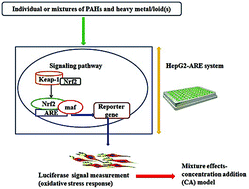Effects of multi-component mixtures of polyaromatic hydrocarbons and heavy metal/loid(s) on Nrf2-antioxidant response element (ARE) pathway in ARE reporter-HepG2 cells†
Abstract
Exposure to polyaromatic hydrocarbons (PAHs) and heavy metal/loid(s) has been demonstrated to induce an oxidative stress response in mammalian cells. The combined effect of PAHs and heavy metal/loid(s) on the oxidative stress response has not been reported extensively. The Nrf2 antioxidant response pathway plays an important role in cellular antioxidant defense against oxidative stress-induced cell damage. In this study, we have determined the combined effect of four PAHs (benzo[a]pyrene (B[a]P), naphthalene (Nap), phenanthrene (Phe) and pyrene (Pyr)) and three heavy metal/loid(s) (arsenic (As), cadmium (Cd) and lead (Pb)) on the Nrf2 antioxidant pathway using the ARE reporter-HepG2 cell line. The mixture study was carried out for binary, ternary, quaternary and seven-component combinations of PAHs and heavy metal/loid(s). Initially, individual dose responses for the PAHs (B[a]P, Nap, Phe and Pyr) and heavy metal/loid(s) (As, Cd and Pb), as well as their respective concentrations that induced an induction ratio of 1.5 (ECIR1.5), were determined. The luciferase assay system was used to quantify the induction of the Nrf2 antioxidant pathway. The individual dose response study showed that both PAHs and heavy metal/loid(s) activated the Nrf2 antioxidant pathway in ARE reporter-HepG2 cells. Among these chemicals, Cd was the most potent inducer, followed by B[a]P and As. Based on the individual dose response findings, PAHs and heavy metal/loid(s) were mixed at equipotent ratios using a fixed concentration ratio, and the effects of the mixtures of PAHs and heavy metal/loid(s) (binary to seven-component) on the Nrf2 antioxidant pathway were determined. The mixture effects were predicted by using the concentration addition (CA) model. Overall, the results showed that the multi-component mixtures of PAHs and heavy metal/loid(s) induced an oxidative stress response in ARE reporter-HepG2 cells, and that the CA model is an appropriate model to predict the interaction effect of these selected mixtures. A human cell line-based reporter gene assay system was successfully used to determine the mixture effects of two groups of common contaminants on oxidative stress response pathway.


 Please wait while we load your content...
Please wait while we load your content...